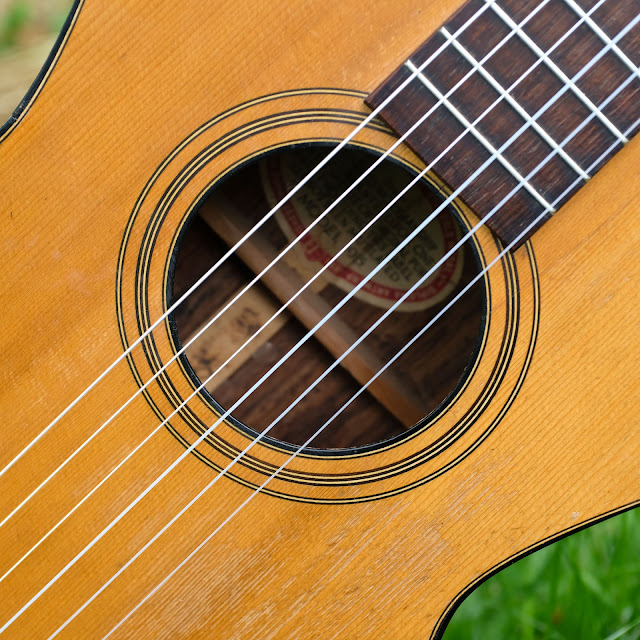1920s Washburn 2227 Concert Guitar
The last time I saw this guitar was in 2009 before it came back, late last year, to get spruced-up for consignment. My repair skills have increased substantially since then, so this time around it got all the work it needed to make it a spot-on player. I also figured I should just re-do the post entirely as I've learned a lot more about the history of these guitars since then.
The model name is 22 for "size 2" = concert and "2" = rosewood back rather than mahogany (as far as I can tell). The 27 is what this cost -- $27 -- in the span from 1920-1923 when this was probably sold. Lyon & Healy serial numbers are a bit vague as far as dating-from goes. These guitars had a bit of a redesign and re-designation in the mid-20s and this one seems to follow the specs of very-late-teens and early-20s models.
Anyhow, a customer of mine poked me about getting this one ready and so I did. It got a neck reset, fret level/dress, some seam repairs, and a new saddle slot cut and new ebony saddle installed. There are numerous repaired side cracks that were crudely-fixed when it came to me in the first place, but I've added extra reinforcement and tidied them up a little where I could. It's now playing beautifully with a straight neck and spot-on 3/32" action at the 12th fret, strung with Aquila Nylgut. While folks often string these with steel, they're not really built for it and sound best with gut/nylon/hybrid classical strings.
The top is solid spruce with ladder bracing, the back and sides are solid Brazilian rosewood, the neck is mahogany, and the fretboard and bridge are rosewood or something very similar to it. The top is crack-free save for a couple of very tiny hairlines over the kerfing on the lower-bout treble side, but the back and sides -- as stated -- have a number of repaired cracks. Sound-wise, this is very typical for a nicer-grade parlor gut-stringer from the time and has a clean, refined, classical voicing. It's a little warmer and fuller on the low-end than many similar period guitars, however, and has good sustain.
Specs are: 24 5/8" scale, 1 3/4" nut width, 1 17/32" string spacing at the nut, 2 5/16" spacing at the bridge, 13 1/8" lower bout, 9 1/2" upper bout, and 3 7/8" depth at the endblock. The neck has something like a 16" radius to the fretboard and a medium-big, hard-V back profile.
This guitar has a headstock hairline crack repair near the bottom of its center column that was done long, long ago. I re-repaired it a bit better this time around and cleaned-up the leavings of the repair work. The nut is original and bone.
The board has pearl dots and medium-sized, nickel-silver frets with lots of life left.
Check out that fancy binding, huh? It has two-ply extra layers on either side of its "main" square of black trim.
I have no definitive proof, but I get the feeling that these guitars were made by Regal for Lyon & Healy as they're trimmed, built, and finished just like the Washburn mandolins that were definitely made by Regal (as identical models are found with Regal markings and in Regal catalogs).
My new saddle slot is drop-in for easy action adjustments. I used ebony as it seems to give a mellower vibe than bone with these old gut-stringers.
The bridge pins are original.
The inlaid, stripey backstrip is pretty nice.
Here's that one longer (repaired/cleated) back crack.
Here you can see the headstock crack that's been repaired. It was a pretty shallow split and has been stable for as long as I've known the guitar.
The side cracks extend all the way around the lower bout and to the endpin. Surprisingly, the endblock doesn't seem to have been damaged, though. There are cleats and glued-fabric reinforcement patches all over the inside to stabilize these.




























Comments